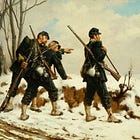During the Prussian War of Liberation (1813-1815), the most important difference between the methods of the Jäger and those of other light troops lay in the realm of scale. Jäger were accustomed to moving and fighting in units that ranged in size from a company of about one hundred rifles down to a ‘fire team’ of two or three men. Using stealth and close terrain to compensate for the weak firepower of these units, Jäger tactics relied heavily on such techniques as the ambush and the conversion of houses into small fortresses. Other Prussian light troops, on the other hand, rarely fought in units smaller than a company.
The difference in the size of units employed did much to shape the geometry of engagements. Whereas ten Jäger might form a bent line to achieve a cross fire, other Prussian light troops could only achieve the same effect at echelons above the company. In other words, the tactics of the Prussian line infantry during the last two years of the Napoleonic era tended to resemble those of the similarly trained and motivated French of the previous decade rather than those of the more subtle Jäger.
The chief cause of the difference between Jäger and other light troops lay in the length of time devoted to training. Like the French who had followed the young Bonaparte, most of the Prussians who served in the Wars of Liberation were conscripts called to the colors a few weeks before the start of a campaign. Prussian Jäger units, on the other hand, maintained the old practice of enlisting men who had grown up in the woods. As a result, Jäger units continued to benefit from ‘pre-induction’ training in stalking and sharpshooting while infantry outfits of other sorts made do men who for the most part, had little, if any, experience with hunting, woodcraft, or firearms.
These imperfections notwithstanding, the reformed Prussian infantry was sufficiently flexible to provide the Prussian commanders with the teeth that they needed to carry out the campaigns of operational maneuver of Scharnhorst and Gneisenau. In the brigade and division battles that preceded Napoleon’s encirclement at Leipzig, Prussian infantry fighting in open order were so consistently superior to their French counterparts that the latter were frequently pushed back into the main body of their army.
Sources:
Peter Hofschröer Prussian Light Infantry, 1792-1815 (London: Osprey, 1984)
Curt Jany Geschichte der Preußischen Armee vom 15. Jahrhundert bis 1914 (Osnabruck: Biblio Verlag, 1967)
Paul Pietsch Die Formations und Uniformierungs-Geschichte des preußischen Heeres 1808-1914 (Hamburg: Verlag Helmut Gerhard Schulz, 1963)
The link will take you to the website of Osprey Publishing.
For Further Reading:





